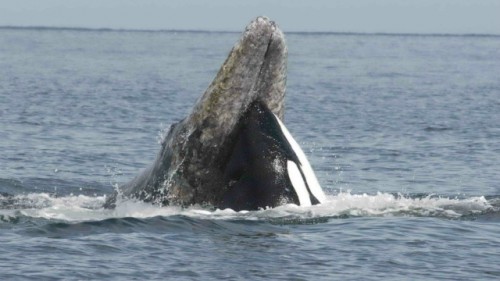Mostly, the killer whales native to Puget Sound are salmon eaters. But there are also transient orca who cruise through the Sound, and their diets may be a bit more adventurous. And then this week the gray whales were passing by, and…uh-oh. Gang fight.
It’s that time of year.
The Great Migration of 22,000 Eastern North Pacific grays is well underway. As spring approaches, these massive creatures, which can reach 50 feet and 40 tons, begin an epic journey of between 5,000 and 6,800 miles from the warm-water calving lagoons in Mexico’s Baja Peninsula and Gulf of California to the Bering and Chukchi Seas, traveling constantly at about five knots and averaging 75 miles per day. It’s the longest migration of any mammal on Earth. Midway through the journey, from late February to the end of May, a small group makes a pit stop in Puget Sound — for the shrimp buffet.



When you’re a Bigg’s
You’re a Bigg’s all the way
From your first salmon gigs
To your last dyin’ day
Those damn Canadian orcas.
Isn’t it time to build the wall?
/s
I’m surprised there is no video of the tussle. Didn’t any of the lookers-on have a smart phone handy???
That’s just so nice, and sweet, and happily awe-filled, it made my day.
rabbitbrush:
If I was out whale watching, I’d have my camera gear, and be taking photos. Just like I do when watching dinosaurs. Fuck smartphones.
Sounds like the kid learned its lesson and no one got hurt. Good outcome all around.
One of the joys of living on the Monterey Peninsula was going out on the whale-watching boats.
When our grandson came to visit, we took him out. The captain got us into the middle of a pod of twelve gray whales, thrilling the grandson. I happily took any visitors who came to see us out whale watching.
I also found it fun to go out with some of the young ladies from our spouses’ club. I always laughed when a few of them became quite seasick. I was lucky that I didn’t get seasick. It was such fun to watch how thrilled people were to see a whale for the first time.
Wow, I miss living out there!
“Didn’t any of the lookers-on have a smart phone handy???”
Those who take wildlife pictures use cameras with huge lenses because they observe from a good distance. Especially when they are legally required to keep certain distance away to not disturb the animals. What you would see from a smartphone would be a few blurry dark blobs popping in and out of the water — the water that takes up most of the screen.
There is a wetlands area near where I live that is very popular with birders. These guys carry cameras with lenses that are longer than any smartphone. The phone, not just the phone’s camera lens. Smartphones cameras have improved lots over the past few years, but not to the point of replacing some serious telephoto lenses.
Jeezo, I only mentioned smartphones because they are so ubiquitous. More people have those than real cameras. Myself, I’d have my Nikon with its 350mm zoom and wide angle lenses.
Most DSLRs released in the past few years (and probably longer, but I don’t keep up on them that much) have the ability to take 1080p video at telephoto zoom. That means they can’t take pictures, but I’d think someone would have wanted to capture it.
Unless, at that distance the camera wobble would be way too high for video? I just thought of that, and that’s probably the answer. Image stabilization can only do so much.
Wait, wait, wait… Somebody said shrimp buffet!
Oh, come on now. Those Biggs’ orca belong in the Salish Sea just as much as the Southern Residents do. They just have a bigger habitat so they spend less time with us!
The Northern Residents are my bag – they keep me in research and, y’know, employed – so I don’t know the the mammal munchers anywhere near as well. They put on a hell of a show though. It’s bizarre because, to the untrained eye, they look no different than the piscivorous populations. The Pacific white-sided dolphins (or, at least, the smart ones) must be able to differentiate between transient (Biggs’) and resident language though because the white-sided dolphins will even swim with, sometimes seemingly harrassing, the residents. When the Biggs’ show up though the white-sided dolphins clear the fuck out because they know they’re about to be lunch.
Likewise, the resident populations will harrass and kill but never eat harbour and Dalls’ porpoises. I’ve never seen them do this to a Pacific white-sided dolphin.
Oh, wow! There is smartphone video of a gray whale in Seattle at the Ballard Locks:
http://mynorthwest.com/11/2945804/Gray-whale-captured-on-video-at-the-Ballard-locks
Well, there are lots of videos of the whale at the locks:
http://www.kiro7.com/news/grey-whale-spotted-in-ballard-locks/199955493
Now, why can’t we get just as good video evidence of bigfoot, UFOs, and other claims?